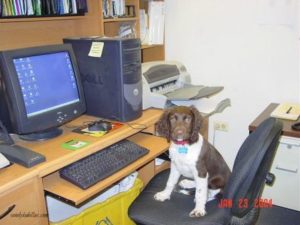I once commented to my boss about how I would love a job where I could take my dog to work. She told me to try it. That was over two decades ago and I have had dogs at work ever since.
A positive experience is a must, or you may not get permission to bring your dog again.
Preparation is key:
- Get permission from your boss!
- Only bring a well-trained, calm and friendly dog.

- Bring a bed, water dish, treats and a few toys. A crate is also a good idea—especially if you might have to leave your dog alone for short periods. A baby gate may also be helpful to keep your dog in your office.
- Put out a dog treat jar where strangers are likely to meet your dog. I work at a very small company, and the mail lady suggested this trick. My dog learned to love the mail lady, the UPS delivery guy and anyone who entered.
- If there are other dogs at work introduce them and make sure they get along or keep them separate. For years we had a “warehouse” dog and an “office” dog, since my “office” dog didn’t like the other.
- Plan time for dog walks and find a potty area. Your dog will feel stressed and need some outside time. I used to walk my dog at lunch time around the block and take her outside for a potty break every two hours—a total of three breaks each day. These walks helped me de-stress too.
- Make sure your dog will not bark when you are on the phone or in a meeting. My first dog was good, while my second one barked a lot. I tried squirting her with water from a spray bottle, then using diluted Listerine when water alone didn’t work (recommended by a dog trainer). Neither of these worked. I finally had to resort to a no-bark collar when she was at work. I didn’t like the idea, but it was the only way I could keep her quiet. She eventually learned and I no longer needed it.
- Be ready to clean up after your dog with baggies, paper towels and rug cleaner solution. Even well-trained dogs can have accidents in new situations, or she could spit up.
- You will need to spend some time with your dog during work, praising and petting, and giving her something to do. So don’t plan to bring your dog on a very hectic day.
- Make sure your work area is free of hazards such as loose wires; things she could trip over and damage; chemicals she could get into, etc.
- You may want to bring your dog on a short day to see how she does. It could be a very long and unproductive day if it goes badly.
- Don’t be nervous. Your dog will pick up on your cues and this could increase her stress causing her to bark, scratch at doors or cause damage.
By following the tips above with a lot of planning and preparation you should have a good day—and if you’re lucky, she’ll be welcomed back.
The best scenario is to bring your dog to work every day. I did for two decades and it strengthened the bond between us and with my colleagues.
This is a BlogPaws “Wordless Wednesday” blog hop. Please comment below or contact me. Also visit the other blogs and leave comments.



Wish I could bring my dog to work with me. Unfortunately we’ve got too may people who’s afraid of dogs in the work place.